2012年07月21日
Smith & Wesson Bodyguards
私たちのブログを訪問していただきありがとうございます。あなたがお持ちの場合DIYの要求は私達に電子メールを送信してください。
Laser-equipped deep-cover .38 snubbie and .380 auto — ideal for back-up carry!
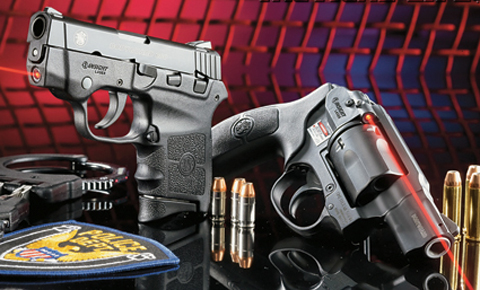
WHEN IT COMES TO HAVING A CORNER ON THE DEEP-COVER carry market, nobody beats out Smith & Wesson. Beginning with the “Chief’s Special,” an ultra-compact snubnose packing five rounds of .38 Special into the tiny J-frame package, the company created the basis for what would become the iconic deep-concealment revolver and back-up gun for law enforcement officers around the country.
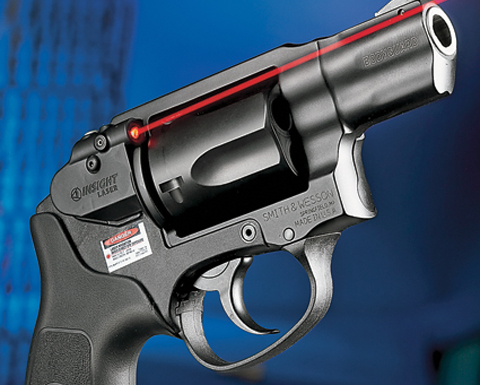
An integrated Insight red laser sight assembly is located to the right rear of the cylinder on the Bodyguard 38.
With lightweight variants, differently chambered versions, and ones with longer barrels or different grips or different sights, it seemed that just about every variation of the design was developed for every conceivable contingency. However, at its core, the classic J-frame was a design from a different era, being first offered in the 1950s, and one that was both time-consuming and relatively expensive to manufacture.
Although sales were (and still are) extremely strong on the traditional J-frames, Smith & Wesson recognized that there was a need for the development of a radically modern deep-concealment revolver—one that took advantage of the most modern of materials and construction methods and that hit a lower retail price point.
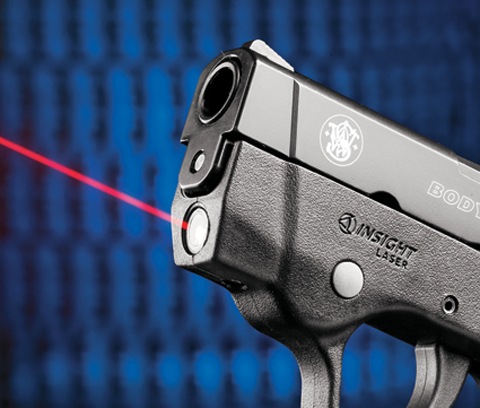
The Insight laser module of the 380 is internally located within the dustcover portion of the polymer frame. Note the light gray round activation button.
Concurrent with this realization was an acknowledgement on Smith & Wesson’s part of the extreme demand in the market for deep-concealment semi-autos chambered in .380 ACP that offered good power in a very small package. In response, the company began the process of developing what we now know today as the “Bodyguards”—a .38 Special revolver and .380 ACP sub-compact autopistol.
Laser-equipped deep-cover .38 snubbie and .380 auto — ideal for back-up carry!

WHEN IT COMES TO HAVING A CORNER ON THE DEEP-COVER carry market, nobody beats out Smith & Wesson. Beginning with the “Chief’s Special,” an ultra-compact snubnose packing five rounds of .38 Special into the tiny J-frame package, the company created the basis for what would become the iconic deep-concealment revolver and back-up gun for law enforcement officers around the country.

An integrated Insight red laser sight assembly is located to the right rear of the cylinder on the Bodyguard 38.
With lightweight variants, differently chambered versions, and ones with longer barrels or different grips or different sights, it seemed that just about every variation of the design was developed for every conceivable contingency. However, at its core, the classic J-frame was a design from a different era, being first offered in the 1950s, and one that was both time-consuming and relatively expensive to manufacture.
Although sales were (and still are) extremely strong on the traditional J-frames, Smith & Wesson recognized that there was a need for the development of a radically modern deep-concealment revolver—one that took advantage of the most modern of materials and construction methods and that hit a lower retail price point.

The Insight laser module of the 380 is internally located within the dustcover portion of the polymer frame. Note the light gray round activation button.
Concurrent with this realization was an acknowledgement on Smith & Wesson’s part of the extreme demand in the market for deep-concealment semi-autos chambered in .380 ACP that offered good power in a very small package. In response, the company began the process of developing what we now know today as the “Bodyguards”—a .38 Special revolver and .380 ACP sub-compact autopistol.
Posted by echigoyaworks
at 19:00
2012年07月21日
Arctic S.W.A.T
私たちのブログを訪問していただきありがとうございます。あなたがお持ちの場合DIYの要求は私達に電子メールを送信してください。
Last frontier lawmen protect 2,000 square miles of extreme country with cutting-edge weapons and tactics!
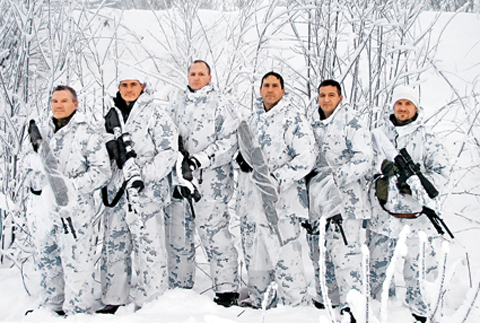
Members of the APD S.W.A.T. sniper team blend into their arctic surroundings with MARPAT overwhites. Knight’s Armament SR-25 MK 11 rifles are their main guns.
“APD, Channel One units, respond to an 11-5 in progress at 4501 Elmore Road. Complainant advises there is a bear charging their sliding glass door.”
That’s not an everyday call, but it’s not uncommon, either, when you’re a police officer in Anchorage, Alaska. I first saw Anchorage in March of 1978. I was a few years out of the Army and was trying to get hired as an Alaska State Trooper. I was blown away that the ice on the parking lot was still 2 inches thick, there was 2 feet of snow on the ground, and that it was 16 degrees. It was offset by the fact that I was in Alaska.
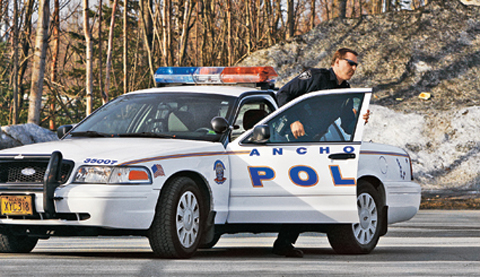
Anchorage officers are cross-trained to handle many duties. Strong community relations are a key tactic in helping to keep the peace.
Anchorage is policed by the Anchorage Police Department (APD). The Municipality of Anchorage is the largest in Alaska. The population of nearly 300,000 souls is almost half the population of the state, but 90 percent of the state’s residents use Anchorage as their transportation, shopping and recreation hub. Lots of rural residents come to town to see the lights, party a little too hard and need police services. Police calls are made more difficult when the temperature is -30, with a 10 mph wind blowing off the inlet. Summers are fairly short and intense; with 24 hours of daylight, Alaskans tend to ignore sleep, knowing they can catch up in December. It can result in long, hard workdays for the APD.
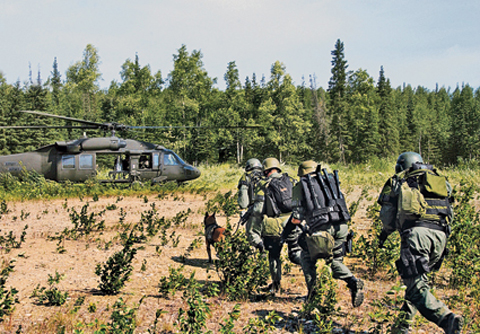
Anchorage S.W.A.T. practices mobile air operations with a Black Hawk helicopter, which they use to deploy to remote areas faster.
Since Anchorage is a “distance-isolated city in a distance-isolated state,” the APD relies on excellent police-community relations to accomplish the mission. There is constant demand for demonstrations from schools, youth groups and job fairs, and vehicles and K-9s are special hits with school kids. In order to maintain close public ties, the APD uses outreach teams, school resource officers and a citizen police academy to improve communication and cooperation; a volunteer Search Team helps find lost folks and search for evidence. The APD is also moving toward assigning officers to the same areas in an effort to form stronger community ties.
BLOG ARCHIVES

Last frontier lawmen protect 2,000 square miles of extreme country with cutting-edge weapons and tactics!

Members of the APD S.W.A.T. sniper team blend into their arctic surroundings with MARPAT overwhites. Knight’s Armament SR-25 MK 11 rifles are their main guns.
“APD, Channel One units, respond to an 11-5 in progress at 4501 Elmore Road. Complainant advises there is a bear charging their sliding glass door.”
That’s not an everyday call, but it’s not uncommon, either, when you’re a police officer in Anchorage, Alaska. I first saw Anchorage in March of 1978. I was a few years out of the Army and was trying to get hired as an Alaska State Trooper. I was blown away that the ice on the parking lot was still 2 inches thick, there was 2 feet of snow on the ground, and that it was 16 degrees. It was offset by the fact that I was in Alaska.

Anchorage officers are cross-trained to handle many duties. Strong community relations are a key tactic in helping to keep the peace.
Anchorage is policed by the Anchorage Police Department (APD). The Municipality of Anchorage is the largest in Alaska. The population of nearly 300,000 souls is almost half the population of the state, but 90 percent of the state’s residents use Anchorage as their transportation, shopping and recreation hub. Lots of rural residents come to town to see the lights, party a little too hard and need police services. Police calls are made more difficult when the temperature is -30, with a 10 mph wind blowing off the inlet. Summers are fairly short and intense; with 24 hours of daylight, Alaskans tend to ignore sleep, knowing they can catch up in December. It can result in long, hard workdays for the APD.

Anchorage S.W.A.T. practices mobile air operations with a Black Hawk helicopter, which they use to deploy to remote areas faster.
Since Anchorage is a “distance-isolated city in a distance-isolated state,” the APD relies on excellent police-community relations to accomplish the mission. There is constant demand for demonstrations from schools, youth groups and job fairs, and vehicles and K-9s are special hits with school kids. In order to maintain close public ties, the APD uses outreach teams, school resource officers and a citizen police academy to improve communication and cooperation; a volunteer Search Team helps find lost folks and search for evidence. The APD is also moving toward assigning officers to the same areas in an effort to form stronger community ties.
BLOG ARCHIVES

Posted by echigoyaworks
at 12:00

